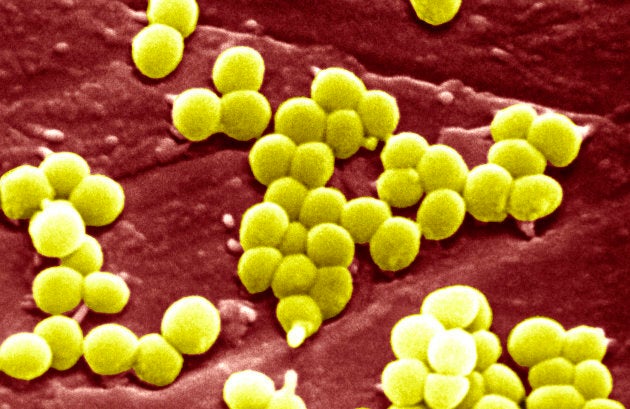Hundreds of bacterial species make a home in and on our bodies. Collectively, they are known as the normal flora. Most of the time, these microscopic inhabitants are happy to go about their lives without causing us any trouble. Yet some types can become turncoats and end up turning into infection-causing enemies.
One such double-crosser is Staphylococcus aureus. It's one of the most common species on Earth and can be found in a third of us, on average. The bacteria prefer to live in warm, damp areas such as the nose and areas of the skin known as the axillary regions.

Normally, S. aureus is harmless, but this species does have a dark side. In certain circumstances, the bacteria can become one of our most feared pathogens. The list of infections is long and ranges from minor troubles such as boils to life-threatening conditions such as sepsis. Many strains are also antibiotic resistant, making treatment difficult at best.
For decades, researchers tried to understand how this bacterium could be both friend and foe. In the 1950s, the idea of two different types of S. aureus — good and bad — gained some traction. A person capable of dealing with a bad strain would transmit the culprit to another individual more susceptible to infection.
But this idea changed in the following decade as researchers discovered a rather disturbing trend. Although transmission of bacteria occurred, those who ended up with infections already had the bacteria in their noses. Apparently, nasal carriage was all it took to put a person at risk. Over the coming years, other studies came to the same conclusion. Simply having the bacterium as a part of the normal flora was enough to put a person at risk for a severe infection.
Evidence revealed an immune system in combat was enough to turn the species against us.
The realization of this two-faced bacterial behaviour prompted researchers to find out what our bodies might be doing to trigger the switch at the molecular level. The first question turned out to be the easier to answer. Evidence revealed an immune system in combat was enough to turn the species against us.
When sick or recovering from an invasive procedure such as an operation, the immune system tends to get stuck in a fog of war and start attacking innocent bystanders, including normal flora. As a means of survival, the bacteria act defensively and start to produce tactical weaponry such as toxins and other protective proteins. The already embattled immune system simply cannot deal with the new attack and the bacterium takes over. As to the mechanism behind the switch, research has revealed harmless forms of the bacteria mutate in order to turn into our foe. But how that happened has continued to be a mystery.
Now we may have the answer thanks to a British team of researchers. They have identified how this transition occurs at the molecular level. The results reveal the process is not trigger-based as once thought, but rather a trade-off between harmless colonization and infection-causing invasion.

The team looked at the genetic nature of S. aureus in people suffering from severe infections. They wanted to find links to the normal flora versions living in the nose. This would then allow them to find the missing switch that turned a harmless bacterium into a serious invader.
What they found, however, was not a switch. Instead, the team discovered numerous changes in the genetic code occurring over time. There was a hidden evolution happening within the colony that could be detected as well as followed over time.
More blogs from Jason Tetro:
Based on the results, the bacteria first colonize the nasal cavity and become part of the normal flora. At this point, all is well. But when the immune system is triggered by other infections, chronic diseases or medical procedures, certain members of the colony mutate and gain the ability to cause infection, although they may not do so at this stage.
As the mutations accumulate, however, the chances for troubles increase. Eventually, some of the bacteria will reach a point of evolution in which they can cause a severe infection. Once this stage has been reached, all that's needed is the opportunity to access a vulnerable part of the body, such as the lungs, wounds or the bloodstream. Should this happen, troubles for the individual are inevitable.
Perhaps the most important needs are to avoid infection and minimize chronic diseases.
The outcome of this study and the many that came before it reveal some of the challenges of our relationship with bacteria. While we may tend to view many as harmless, due to circumstances beyond our control — such as evolution — we may find ourselves victims of infections. Preventing these issues may not be easy, but based on the results, there are a few options.
Perhaps the most important needs are to avoid infection and minimize chronic diseases. This means keeping up with hygienic practices and keeping your body healthy through proper diet and exercise. Although these regimens may not completely prevent the bacterial evolution within, by keeping the immune system balanced, you may be able to minimize the mutations and prevent a nasal colonizer from turning into a nefarious invader.
Follow HuffPost Canada Blogs on Facebook
Also on HuffPost: